|
|
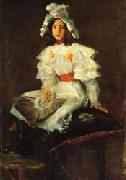 |
William Merritt Chase
|
|
American Impressionist Painter, 1849-1916
American painter and printmaker. He received his early training in Indianapolis from the portrait painter Barton S. Hays (1826-75). In 1869 he went to New York to study at the National Academy of Design where he exhibited in 1871. That year he joined his family in St Louis, where John Mulvaney (1844-1906) encouraged him to study in Munich. With the support of several local patrons, enabling him to live abroad for the next six years, Chase entered the Kenigliche Akademie in Munich in 1872. Among his teachers were Alexander von Wagner (1838-1919), Karl Theodor von Piloty and Wilhelm von Diez (1839-1907). Chase also admired the work of Wilhelm Leibl. The school emphasized bravura brushwork, a technique that became integral to Chase's style, favoured a dark palette and encouraged the study of Old Master painters, particularly Diego Velezquez and Frans Hals. Among Chase's friends in Munich were the American artists Walter Shirlaw, J. Frank Currier and Frederick Dielman (1847-1935) |
|
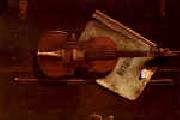 |
William Michael Harnett
|
|
1851-1892
Harnett was born in Clonakilty, County Cork, Ireland during the time of the potato famine. Shortly after his birth his family emigrated to America, settling in Philadelphia. Becoming a United States citizen in 1868, he made a living as a young man by engraving designs on table silver, while also taking night classes at the Pennsylvania Academy of the Fine Arts and later, in New York, at Cooper Union and at the National Academy of Design. His first known oil painting, a still life, dates from 1874.
The style of trompe l'oeil painting that Harnett developed was distinctive and inspired many imitators, but it was not without precedent. A number of 17th century Dutch painters, Pieter Claesz. for instance, had specialized in tabletop still life of astonishing verisimilitude. Raphaelle Peale, working in Philadelphia in the early 19th century, pioneered the form in America. What sets Harnett's work apart, besides his enormous skill, is his interest in depicting objects not usually made the subject of a painting.
Harnett painted musical instruments, hanging game, and tankards, but also painted the unconventional Golden Horseshoe (1886), a single rusted horseshoe shown nailed to a board. He painted a casual jumble of second-hand books set on top of a crate, Job Lot, Cheap (1878), as well as firearms and even paper currency. His works sold well, but they were more likely to be found hanging in a tavern or a business office than in a museum, as they did not conform to contemporary notions of high art.
Harnett spent the years 1880?C1886 in Europe, staying in Munich from 1881 until early 1885. Harnett's best-known paintings, the four versions of After The Hunt, were painted between 1883 and 1885. Each is an imposing composition of hunting equipment and dead game, hanging on a door with ornate hinges at the right and keyhole plate at the left. These paintings, like the horseshoe or currency depictions mentioned earlier, are especially effective as trompe l'oeil because the objects occupy a shallow space, meaning that the illusion is not spoiled by parallax shift if the viewer moves.
Overall, Harnett's work is most comparable to that of the slightly younger John F. Peto. The two artists knew each other, and a comparison can be made between two paintings featuring violins. Harnett's Music and Good Luck from 1888 shows the violin hanging upright on a door with ornate hinges and with a slightly torn piece of sheet music behind it. The elements are arranged in a stable, deliberate manner. Peto's 1890 painting shows the violin hanging askew, as well as chipped and worn, with one string broken. The sheet music is dog-eared and torn around the edges, and placed haphazardly behind the instrument. The hinges are less ornate, and one is broken. Harnett's objects show signs of use but are well preserved, while Peto's more humble objects are nearly used up.
Crippling rheumatism plagued Harnett in his last years, reducing the number but not the quality of his paintings. He died in New York City in 1892. Other artists who painted similar compositions in Harnett's wake include his contemporary John Haberle and successors such as Otis Kaye and Jefferson David Chalfant. |
|
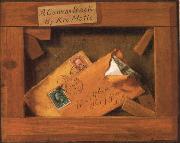 |
William Morris Davis
|
|
February 12, 1850 - February 5, 1934,Davis, who was born in Philadelphia, Pennsylvania, was educated at Harvard. He returned to teach there in 1877 after a period as a meteorologist in Argentina and as an assistant with the North Pacific Survey. He became professor of physical geography in 1890 and of geology in 1898. Davis is acknowledged as the founder of geomorphology, the study of landforms. In his The Rivers and Valleys of Pennsylvania (1889) he first introduced what later became known as the Davisian systems of landscape analysis. His aim was to provide an explanatory description of how landforms change in an ideal situation and his most important contribution to this was his introduction of the cycle of erosion into geographical thought. He proposed a complete cycle of youth, maturity, and old age to describe the evolution of a landscape. In youth rivers occupy steep V-shaped valleys while in old age the valleys are broad. The end product would be a flat featureless plain he called a epeneplaine. This was an ideal cycle but in practice the cycle would invariably be interrupted by Earth movements. It was, nevertheless, strongly attacked by German geographers who objected to it on the grounds that it neglected such vital factors as weathering and climate in transforming the landscape. They also believed him to be undermining their argument that landforms could only be discovered by local fieldwork and the production of regional monographs. Davis also produced an influential work, |
|
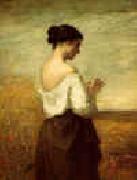 |
William Morris Hunt
|
|
1824- 1879
William Morris Hunt Gallery
Hunt's father's family were among Vermont's founders and largest landowners; his mother's a family of wealth and prominence in Connecticut. Hunt attended Harvard but withdrew in his junior year.
Following the untimely death of his Congressman father from cholera, Hunt's mother Jane took him and his brothers to Switzerland, the South of France and to Rome, where Hunt studied with Couture in Paris and then came under the influence of Jean-François Millet, from whom he learned the principles of the Barbizon school. The Hunt family remained in Europe for a dozen years.
Afterwards, leaving Paris, he painted and established art schools at Newport, Rhode Island, where he had relatives, Brattleboro, Vermont, Faial Island in the Azores, where he had family connections and finally at Boston, where he painted, taught art and became a popular portrait painter.
The companionship of Millet had a lasting influence on Hunt's character and style, and his work grew in strength, in beauty and in seriousness. He was among the biggest proponents of the Barbizon school in America, and he more than any other turned the rising generation of American painters towards Paris.
On his return in 1855 he painted some of his most handsome canvases, all reminiscent of his life in France and of Millet's influence. Such are The Belated Kid, Girl at the Fountain, Hurdy-Gurdy Boy, and others ?C but the public called for portraits, and it became the fashion to sit for Hunt; among his best paintings of this genre are those of William M. Evarts, Mrs Charles Francis Adams, the Rev. James Freeman Clarke, William H. Gardner, Chief Justice Shaw and Judge Horace Gray.
Sadly, many of Hunt's paintings and sketches, together with five large Millets and other art treasures collected by him in Europe, were destroyed in the Great Boston Fire of 1872. |
|
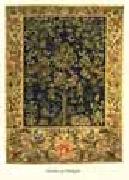 |
William Morris Prints
|
|
English Pre-Raphaelite Writer and Designer, 1834-1896
was an English architect, furniture and textile designer, artist, writer, and socialist associated with the Pre-Raphaelite Brotherhood and the English Arts and Crafts Movement.
Born in Walthamstow in north London, Morris was educated at Marlborough and Oxford. In 1856, Morris became an apprentice to Gothic revival architect G. E. Street. That same year he founded the Oxford and Cambridge Magazine, an outlet for his poetry and a forum for development of his theories of hand-craftsmanship in the decorative arts. In 1861, Morris founded a design firm in partnership with the artist Edward Burne-Jones, and the poet and artist Dante Gabriel Rossetti which had a profound impact on the decoration of churches and houses into the early 20th century. Morris's chief contribution was as a designer of repeating patterns for wallpapers and textiles, many based on a close observation of nature. Morris was also a major contributor to the resurgence of traditional textile arts and methods of production.
Morris wrote and published poetry, fiction, and translations of ancient and medieval texts throughout his life. His best-known works include The Defence of Guenevere and Other Poems (1858), The Earthly Paradise (1868?C1870), A Dream of John Ball and the utopian News from Nowhere.
Morris was an important figure in the emergence of socialism in Great Britain, founding the Socialist League in 1884, but breaking with the movement over goals and methods by the end of that decade. Morris devoted much of the rest of his life to the Kelmscott Press which he founded in 1891. The 1896 Kelmscott edition of the Works of Geoffrey Chaucer is considered a masterpiece of book design. |
|
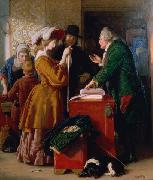 |
William Mulready
|
|
(1 April 1786 - 7 July 1863) was an Irish genre painter living in London. He is best known for his romanticizing depictions of rural scenes, and for creating Mulready stationery letter sheets, issued at the same time as the Penny Black postage stamp.
William Mulready was born in Ennis, County Clare. Early in his life, in 1792, the family moved to London, where he was able to get an education and was taught painting well enough so that he was accepted at the Royal Academy School at the age of fourteen.
Choosing the Wedding Gown
illustrating ch 1 of Vicar of Wakefield by Oliver GoldsmithIn 1802, he married Elizabeth Varley (1784-1864), a landscape painter. Their three children, Paul Augustus (1805-1864), William (1805-1878), and Michael (1807-1889) also became artists. His relationship with his wife however deteriorated gradually over the years, which is detailed in papers stored at the library of the Victoria and Albert Museum. His strong Catholic beliefs prevented any chance of a divorce but they separated. He accused her of "bad conduct" but shied from providing details. In a letter to him in 1827 she blamed him entirely for the collapse of their marriage, suggesting cruelty, pederastic activities and adultery were the reasons.
His son, William Mulready Junior (1805-1878), lived in London and maintained a career of a portrait painter and picture restorer. He had five children (Ellen, Mary, Augustus Edwin, Henry William, and John).They also were trained as artists, but not all of them pursued the artistic career: Henry William and John described themselves as 'house painters'. Augustus Edwin Mulready (1844-1904) was the most successful of them and became known as a member of the Cranbrook Colony of artists.
|
|
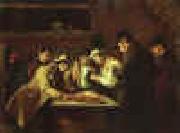 |
William Sidney Mount
|
|
1807-1868
William Sidney Mount Galleries
William Sidney Mount (November 26, 1807 ?C November 19, 1868) born in Setauket, New York was a renowned genre painter and contemporary of the Hudson River School. Mount trained at the National Academy of Design in New York. Two of his more famous paintings are Eel Spearing at Setauket (1845, New York State Historical Association, Cooperstown) and Bargaining for a Horse (1835, New-York Historical Society, New York City). Beginning as a history painter, Mount moved to depicting scenes from everyday life. The largest collection of his works is located in The Long Island Museum of American Art, History, and Carriages
His home and studio, the William Sidney Mount House, is a National Historic Landmark. One of the local elementary schools in The Three Village Central School District is named in his honor, as is PS 174 elementary school in Rego Park, Queens. A residential building is named after him on the Stony Brook University campus. |
|
|
|
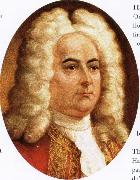 |
wolfgang amadeus mozart
|
|
Born: 27 January 1756
Birthplace: Salzburg, Austria
Died: 5 December 1791 (fever)
Best Known As: Composer of Eine kleine Nachtmusik |
|
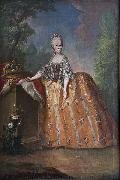 |
Workshop of Anton von Maron
|
|
Anton von Maron (January 8, 1733 - March 3, 1808) was an Austrian painter, active in Rome.
Von Maron was born in Vienna, but moved at a young age to Rome. There, he studied under Anton Raphael Mengs, and became an accomplished portrait painter. He married a sister of Mengs, Therese Maron, who was a painter in her own right. He lived the rest of his life in Rome, and died there in 1808. |
|
|
|
|

